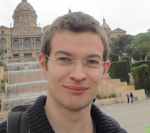CAZypedia celebrates the life of Senior Curator Emeritus Harry Gilbert, a true giant in the field, who passed away in September 2025.
CAZypedia needs your help!
We have many unassigned pages in need of Authors and Responsible Curators. See a page that's out-of-date and just needs a touch-up? - You are also welcome to become a CAZypedian. Here's how.
Scientists at all career stages, including students, are welcome to contribute.
Learn more about CAZypedia's misson here and in this article. Totally new to the CAZy classification? Read this first.
Difference between revisions of "User:Daniel Kracher"
| (2 intermediate revisions by 2 users not shown) | |||
| Line 1: | Line 1: | ||
| + | |||
[[Image:DKracher.png|150px|right]] | [[Image:DKracher.png|150px|right]] | ||
| − | I was born and raised in the south of Austria ( | + | I was born and raised in the south of Austria (Styria) but moved to Vienna to study Food and Biotechnology at the [http://www.boku.ac.at BOKU University]. |
| − | + | My academic journey led me to achieve a Master's and Ph.D. degree in the group of [[User:Roland Ludwig|Roland Ludwig]] [http://www.ludwiglab.at/ (-> link)], where I focused on the investigation of fungal redox-enzymes and their application in biocatalysis and biorefinery processes <cite>Kracher2014 Kracher2013</cite>. During my research, I studied the kinetics and electron transfer reactions of fungal cellobiose dehydrogenases (CDH), which play a vital role in lignocellulose degradation <cite>Kracher2012 Kracher2015 Kracher2015b Ma2017</cite>. | |
The activation of lytic polysaccharide monooxygenases by CDH later became a central point of my research <cite>Kracher2016 Kracher2018</cite>. | The activation of lytic polysaccharide monooxygenases by CDH later became a central point of my research <cite>Kracher2016 Kracher2018</cite>. | ||
| − | + | In 2018, I had the exciting opportunity to join the [http://www.mib.ac.uk/ Manchester Institute of Biotechnology (MIB)] as part of [http://www.sites.google.com/site/scruttonlab/home Prof. Nigel Scrutton`s] dynamic research group where I studied how protein motions govern electron transfer reactions <cite>Kracher2020</cite>. | |
| + | Since 2020, I occupy the position of a University Assistant at the [https://www.tugraz.at/institute/imbt/home Institute of Molecular Biotechnology (IMBT)] at the Graz University of Technology (Graz, Austria). I`m a BioTechMed-Graz-funded research group leader focusing on CAZymes that play a crucial role in host-pathogen interactions. In addition, I´m actively involved in the engineering of biomass-converting enzymes. I enjoy being part of a talented team around Prof. Robert Kourist at IMBT and contributing to cutting-edge research in the field of molecular biotechnology and enzymology. | ||
| Line 24: | Line 26: | ||
#Kracher2018 pmid=29259126 | #Kracher2018 pmid=29259126 | ||
| + | #Kracher2020 pmid=32382450 | ||
</biblio> | </biblio> | ||
Latest revision as of 05:54, 4 August 2023
I was born and raised in the south of Austria (Styria) but moved to Vienna to study Food and Biotechnology at the BOKU University.
My academic journey led me to achieve a Master's and Ph.D. degree in the group of Roland Ludwig (-> link), where I focused on the investigation of fungal redox-enzymes and their application in biocatalysis and biorefinery processes [1, 2]. During my research, I studied the kinetics and electron transfer reactions of fungal cellobiose dehydrogenases (CDH), which play a vital role in lignocellulose degradation [3, 4, 5, 6].
The activation of lytic polysaccharide monooxygenases by CDH later became a central point of my research [7, 8].
In 2018, I had the exciting opportunity to join the Manchester Institute of Biotechnology (MIB) as part of Prof. Nigel Scrutton`s dynamic research group where I studied how protein motions govern electron transfer reactions [9].
Since 2020, I occupy the position of a University Assistant at the Institute of Molecular Biotechnology (IMBT) at the Graz University of Technology (Graz, Austria). I`m a BioTechMed-Graz-funded research group leader focusing on CAZymes that play a crucial role in host-pathogen interactions. In addition, I´m actively involved in the engineering of biomass-converting enzymes. I enjoy being part of a talented team around Prof. Robert Kourist at IMBT and contributing to cutting-edge research in the field of molecular biotechnology and enzymology.
- Kracher D, Oros D, Yao W, Preims M, Rezic I, Haltrich D, Rezic T, and Ludwig R. (2014). Fungal secretomes enhance sugar beet pulp hydrolysis. Biotechnol J. 2014;9(4):483-92. DOI:10.1002/biot.201300214 |
- Mulla D, Kracher D, Ludwig R, Nagy G, Grandits M, Holzer W, Saber Y, Gabra N, Viernstein H, and Unger FM. (2013). Azido derivatives of cellobiose: oxidation at C1 with cellobiose dehydrogenase from Sclerotium rolfsii. Carbohydr Res. 2013;382:86-94. DOI:10.1016/j.carres.2013.09.004 |
- Sygmund C, Kracher D, Scheiblbrandner S, Zahma K, Felice AK, Harreither W, Kittl R, and Ludwig R. (2012). Characterization of the two Neurospora crassa cellobiose dehydrogenases and their connection to oxidative cellulose degradation. Appl Environ Microbiol. 2012;78(17):6161-71. DOI:10.1128/AEM.01503-12 |
- Kracher D, Zahma K, Schulz C, Sygmund C, Gorton L, and Ludwig R. (2015). Inter-domain electron transfer in cellobiose dehydrogenase: modulation by pH and divalent cations. FEBS J. 2015;282(16):3136-48. DOI:10.1111/febs.13310 |
- Tan TC, Kracher D, Gandini R, Sygmund C, Kittl R, Haltrich D, Hällberg BM, Ludwig R, and Divne C. (2015). Structural basis for cellobiose dehydrogenase action during oxidative cellulose degradation. Nat Commun. 2015;6:7542. DOI:10.1038/ncomms8542 |
- Ma S, Preims M, Piumi F, Kappel L, Seiboth B, Record E, Kracher D, and Ludwig R. (2017). Molecular and catalytic properties of fungal extracellular cellobiose dehydrogenase produced in prokaryotic and eukaryotic expression systems. Microb Cell Fact. 2017;16(1):37. DOI:10.1186/s12934-017-0653-5 |
- Kracher D, Scheiblbrandner S, Felice AK, Breslmayr E, Preims M, Ludwicka K, Haltrich D, Eijsink VG, and Ludwig R. (2016). Extracellular electron transfer systems fuel cellulose oxidative degradation. Science. 2016;352(6289):1098-101. DOI:10.1126/science.aaf3165 |
- Kracher D, Andlar M, Furtmüller PG, and Ludwig R. (2018). Active-site copper reduction promotes substrate binding of fungal lytic polysaccharide monooxygenase and reduces stability. J Biol Chem. 2018;293(5):1676-1687. DOI:10.1074/jbc.RA117.000109 |
- Breslmayr E, Laurent CVFP, Scheiblbrandner S, Jerkovic A, Heyes DJ, Oostenbrink C, Ludwig R, Hedison TM, Scrutton NS, and Kracher D. (2020). Protein Conformational Change Is Essential for Reductive Activation of Lytic Polysaccharide Monooxygenase by Cellobiose Dehydrogenase. ACS Catal. 2020;10(9):4842-4853. DOI:10.1021/acscatal.0c00754 |
